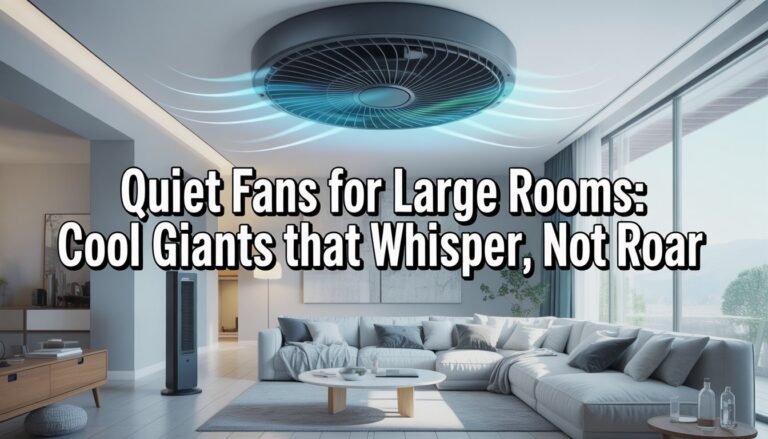Quiet Fans for Sleeping: Dreamy Breezes Without the Jet Engine Experience
Trying to sleep with a loud fan? That’s about as helpful as playing drums to relax—sometimes you just need quiet.
We all know that feeling when the room is stuffy, but turning on a rickety fan sounds like taking off in a jet. That’s why quiet fans for sleeping exist: to keep air moving, help us stay cool, and avoid the soundtrack of a broken lawnmower.
Fans for sleep have a simple job. They move air, cut down on stuffiness, and can even give a gentle white noise.
But let’s be honest—if a fan is too loud, it only adds to the problem. That’s why finding a quiet fan makes such a difference, especially for light sleepers who want to snooze instead of staring at the ceiling.
When picking a fan for sleeping, the biggest thing to watch out for is noise level. Decibels tell us how close this thing is to waking up the dog, honestly.
It also helps to look at features like speed settings, size, and ease of cleaning. After all, we want something that works hard, not something that sounds like it’s working out.
We spent late nights—and early mornings—testing lots of fans to find the best quiet fans for sleeping.
Best Quiet Fans for Sleeping
We all know how hard it is to sleep when our fan sounds like a lawn mower on full throttle. That’s why we’ve done the hard work and found the quietest, most peaceful fans out there.
Let’s check out our top picks so we can all catch some actual Z’s tonight.
Amazon Basics 16″ Pedestal Fan
If we want to keep our sleep cool and quiet without breaking the bank—or waking up our pets—this fan does the trick.
Pros
- Gives us three speed settings, so we’re not trapped in wind tunnel mode all night
- Stands tall and can easily be aimed where we want; no more fighting over airflow
- Remote lets us rule the climate from bed, looking like true air-cooling royalty
Cons
- Setup feels like a mini IKEA adventure (without Swedish meatballs)
- Base takes up more space than a pizza box
- Not totally silent if we crank it to high
After putting this Amazon Basics fan in our bedroom, we found it kept things cool even when the air outside felt like soup. The dual blades move plenty of air without sounding like a leaf blower, especially on lower settings.
Tinkering with the height and tilt was easy, so everyone under our roof got some breeze. The remote control honestly makes us feel a bit lazy, but we’re not complaining when we can control speed and mode without surfacing from the blankets.
The sleep mode is gentle enough that it doesn’t drown out our dreams, but we sometimes hear a soft hum if the room is super quiet—a trade-off we’re willing to live with. Putting this standing fan together took a little muscle and some patience, like playing with adult Legos.
We did appreciate not having to call in a tech support team just for a fan, and after assembly, it sat solidly in place. While the base is kind of wide, it never tipped when our cat did her best to knock it over—which is really all we can ask.
Dreo Nomad One Quiet Tower Fan
If we want a whisper-quiet fan that doesn’t sound like we’re sleeping next to a jet engine, this Dreo Nomad One is a lifesaver for light sleepers.
Pros
- Barely makes a sound, even on higher settings
- Sleek, space-saving design fits right by the bed
- Remote control lets us stay lazy under the covers
Cons
- A bit of assembly is needed out of the box
- LCD display glows brighter than our future (auto-off helps, though)
- Remote is small and easy to misplace in the dark
When we tried out the Dreo Nomad One, we were amazed at how quiet it ran. At times, we had to put our hand up just to double-check it was actually blowing air.
The lowest setting is almost silent, so there’s no annoying droning to keep us awake at night. The sleep mode seems designed for people who hate any extra light or beeping when they’re trying to conk out.
We also love how the tower shape saves us valuable floor space. It’s slim, tall, and, honestly, a little classier than the clunky fans we used to own.
Moving it from room to room wasn’t a struggle thanks to the built-in handle. The included remote means we don’t have to leave our cozy nest to turn the fan up or down—true luxury living.
There’s a lot to choose from on the control panel, so whether we want tropical hurricane or gentle spring breeze, we’re covered. The auto oscillation covers our whole room with minimal effort on our part.
Cleaning the fan is simple, too; nothing makes us feel more accomplished than not losing a finger while removing the grill. While the remote could be bigger (seriously, it’s tiny), the handy storage spot in the back actually kept us from playing hide and seek with it every morning.
If we ever wanted to impress guests with our very adult, very quiet cooling setup, this fan would do the trick.
Dreo Sleepy Breeze Fan
If we want a whisper-quiet fan that moves air like it’s got something to prove, this Dreo is tough to beat.
Pros
- So quiet, we sometimes check if it’s actually on
- Delivers strong airflow across the whole room
- Super easy to clean and keep dust-free
Cons
- Three speeds only—no fancy digital features
- Not cordless, so it’s not picnic-friendly
- Plastic finish doesn’t exactly scream “luxury décor”
Right out of the box, we were pretty sure someone tricked us into thinking this thing was turned off. Luckily, the cool breeze proved otherwise.
Even at night, the Dreo Sleepy Breeze Fan kept our bedroom comfortable without being noisy; it’s quieter than the neighbor’s cat, which is a plus. Playing with the tilt and speed, we got just the right airflow whether lounging on the couch or pretending we didn’t hit snooze six times.
The simple knob control is refreshingly old-school—a nice break from touchscreens and voice commands that never seem to listen anyway. Cleaning this fan is a breeze, literally.
We snapped off the front grill to wipe the blades without doing finger gymnastics. And if we wanted to hang it up on the wall to save space, that worked just fine.
We do wish it had a bit more style, but for a solid, silent night’s sleep, we can live with it.
Honeywell QuietSet Mini Tower Fan
If we’re tired of sweating through our pajamas but want to actually sleep at night, this compact Honeywell fan balances strong airflow with barely-there sound.
Pros
- Super quiet on low settings, great for light sleepers
- Stays put and fits just about anywhere, even our stuffed nightstands
- Four settings let us find the sweet spot between gentle breeze and mini hurricane
Cons
- The bright power light might try to outshine our nightlight and annoy us at bedtime
- Not the best pick for those of us who need a full-on wind tunnel
- No remote, so we have to actually move to adjust it… the horror
We popped this petite tower on our nightstand, and honestly, it’s been a nice change from our old “jet engine in disguise” fan. With four different speeds, we don’t have to fight over settings—everyone can find their own comfort zone.
It barely takes up more room than a coffee mug, which means more space for late-night snacks or water bottles (no judgment here). The noise level is impressive.
On sleep mode, we barely hear it. It manages to cool us down without any annoying rattles, and it doesn’t wobble or tip over if we nudge the table in our sleep.
However, whoever designed that glowing power light clearly didn’t consider our delicate eyeballs at 2 AM. If we’re picky about total darkness, a bit of creative tape placement may be needed.
We’ve noticed easier breathing and way less stuffiness in the room since using it. It’s also light enough that we can drag it from desk to bed, which helps us keep our cool during muggy afternoons and long summer nights.
We do wish it had a remote for our lazier moments, but we guess that’s why we have arms. For quiet, personal cooling that won’t keep us up, the Honeywell QuietSet definitely earns a spot on our side table.
LEVOIT Quiet Tower Fan
If we want a fan that won’t sound like a jet engine but will keep us from sweating off the sheets, the LEVOIT Quiet Tower Fan is worth a look.
Pros
- Nearly silent—even on higher speeds
- Handy remote for the laziest among us
- Sleep mode actually lets us, you know, sleep
Cons
- Assembly could cause mild confusion
- Touch controls can be fussy when half awake
- Won’t win any fashion awards for its looks
Let’s talk about how peaceful this fan is—it whispers along at night, barely making a sound, which is exactly what we want when we’re trying to count sheep.
That Advanced Sleep Mode is a true highlight; after a long day, it dims everything, hushes the noise, and slowly changes the speed so we don’t wake up shivering at 2 a.m. It’s like it knows we need our beauty rest.
With the remote, we’re living our best lazy people lives. No more late-night ninja rolls out of bed to adjust fan speed or awkwardly reaching for buttons in total darkness.
We found ourselves actually using the different modes. The auto setting responds to the room temperature, so we don’t have to babysit our fan through the night.
Of course, no fan is perfect. Putting it together felt a bit like trying to solve a puzzle with one eye closed—easy enough, but some of us (looking at ourselves here) still managed to put the base on crookedy at first.
The touch controls also tend to ignore us until we press twice; apparently the fan doesn’t trust anyone at 3 a.m. And while it’s not exactly ugly, we won’t be entering it in any home decor contests.
If we’re done being woken up by clunky fans and want simple, hands-off comfort, the LEVOIT Quiet Tower Fan delivers a breezy, almost forgettable (in a good way) sleeping experience.
Honeywell TurboForce Table Fan
If you want a sleep-friendly fan that won’t drown out your dreams, this one’s a solid fit. It doesn’t blast noise all night, but you’ll definitely feel the breeze.
Pros
- Exceptionally quiet, especially on low and medium speeds
- Surprising power for its small size—you will feel that breeze
- Adjustable head lets us aim the airflow right at our face (or our toes)
Cons
- No option to tilt the fan head downward below level
- White color looks a bit off, not as crisp as we’d hoped
- Power plug feels a little stubborn in some outlets
Nobody’s calling the Honeywell TurboForce Table Fan a “gentle whisper.” It’s more like a polite whisper that still gets the job done—quiet enough not to keep you awake, but strong enough to actually move air.
When we parked it on the nightstand, it blended in without hogging space for chargers or whatever else ends up there. The 90-degree pivoting head means you can direct air wherever you want—just twist and you’re back in the breeze.
Changing between three speeds is easy, even if you’re half-asleep and fumbling for the buttons. The hum is tame, and the white noise is just enough to help us sleep.
Design-wise, it’s not going to win any beauty contests. The white looks a little tired, and the plug can be a pain in some outlets. But honestly, it keeps the room cool without sounding like a tornado, and that’s what matters.
Dreo Quiet Fan for Sleep
Tired of loud fans and sleepless nights? This one’s a breath of fresh, quiet air.
Pros
- Whisper-quiet even on higher settings
- Blasts cool air surprisingly far
- Remote control means we never leave bed
Cons
- Vertical tilt has to be adjusted by hand
- Height isn’t sky-high
- Assembly needed (no magic, sadly)
We set up the Dreo Quiet Fan and instantly noticed the peace—no annoying motor buzz. Oscillation moves air around the whole room, so no one’s left sweating in a corner.
Eight wind speeds let us play “weather gods” from bed. The remote is a lifesaver, especially when someone forgets to turn off the fan.
If the remote disappears, the panel works just fine. The LED display is big but dims after a while, so there’s no accidental nightclub glow at bedtime.
We wish the vertical tilt didn’t need hands-on adjusting, and it’s not tall enough for really big spaces. But for most bedrooms, it covers the basics. Cleaning isn’t a chore, and the timer means we don’t wake up to an icebox. It’s one of the rare fans that’s actually “quiet” while still making us feel like we invested in better sleep.
PNTCK Quiet Circulator Fan for Sleeping
When it comes to catching some shut-eye without a hurricane in your ears, this fan keeps things breezy and peaceful.
Pros
- Whisper-quiet on sleep mode—like ninja-level quiet
- Light enough to move with one hand
- Remote lets us control it from bed (no need to become nocturnal ninjas)
Cons
- Remote and fan design aren’t always exactly as pictured
- Not cordless, so we’re stuck near a plug
- Airflow claims can feel a bit ambitious in huge rooms
Set this little powerhouse on sleep mode and you’ll feel air moving, but barely hear a thing. The 120° tilt and 90° oscillation spread cool air all around, so we don’t have to stick a leg out from under the covers.
Touchscreen and remote controls felt like a luxury upgrade. We could stay wrapped up and still adjust the speed or timer with a click.
The compact size fits on a nightstand, desk, pretty much anywhere you need it. In larger rooms, the airflow isn’t quite as heroic as advertised, but for bedrooms, it’s more than enough.
Sometimes the model looks a bit different than the photos, which adds a dash of mystery. If you want a no-fuss, ultra-quiet fan that won’t drown out your thoughts, this one’s hard to beat—unless you’re hoping it’ll do chores, too.
Lasko Wind Machine Fan
Need a fan that cools a room almost as fast as you can lose the remote? The Lasko Wind Machine Fan is up for the job.
Pros
- Moves an impressive amount of air even on low
- Super simple to carry from room to room
- Lets us aim the breeze exactly where we want it
Cons
- Can be a little noisy for light sleepers
- The plastic knobs love to loosen themselves
- Not the prettiest fan for stylish bedrooms
We tried the Lasko Wind Machine in a stuffy bedroom, and wow—this thing moves air like a champ. With three speed settings, setting three feels like standing near a mini wind tunnel (in a good way).
The wide pivot means you don’t have to blast air straight at your face all night. Carrying it from the living room to the bedroom took less effort than finding matching socks, thanks to the big handle.
It’s not exactly stylish, but it keeps us cool. On high, it’s louder than our most dramatic snoring, so light sleepers should stick to the lower setting.
The knobs sometimes loosen themselves, so check them now and then unless you like surprise adjustments.
DR.PREPARE Quiet Tower Fan
If you want to fall asleep without the buzz of a jet engine, this fan’s a worthy bedtime companion.
Pros
- Gentle breeze with barely any noise
- Handy remote for those “I forgot to turn it off” moments
- Safe design—no finger-chomping blades
Cons
- Remote only works if you point straight at the fan
- Display lights can be a bit bright at night
- Needs a wall plug, so not for camping unless you want to pack a generator
Our nights have been surprisingly uneventful with the DR.PREPARE Quiet Tower Fan humming softly in the background. Sometimes we forget it’s on, except for the cool draft making summer nights tolerable.
The remote saves us from getting out of bed when we’re finally comfortable. Adjusting the speed or setting the timer is simple, and once we figured out the panel, we felt like fan wizards.
Just don’t expect the remote to work unless you aim it like you’re playing laser tag. The display lights are pretty bright, so we slapped a sticky note over them at night.
The size is perfect for a dresser or nightstand, and the oscillation makes sure everyone gets a breeze. If you want a quiet room and a steady, gentle draft, we’d say the DR.PREPARE Quiet Tower Fan deserves a spot next to your bed.
Buying Guide
Nobody wants a fan so loud it sounds like a jet taking off next to the bed. When hunting for quiet fans, noise level is the first thing to check—lower decibel ratings are always better for sleep.
Size definitely matters. Tower fans save space if your nightstand is already crowded, while box or pedestal fans move more air if your room gets stuffy.
A remote control saves you from awkward ninja moves across the bedroom at midnight. Multiple speed settings mean you can go from gentle breeze to full blast depending on your mood.
Here’s a quick table to keep our choices straight:
| Feature | Why It Matters |
|---|---|
| Noise Level | Quieter fans help us sleep better |
| Size & Design | Fits our space and style |
| Speed Settings | Lets us adjust airflow easily |
| Remote Control | For the lazy (a.k.a. us) |
| Oscillation | Distributes cool air around the room |
Easy cleaning is a bonus—nobody wants to spend Saturday digging dust bunnies out of tiny vents. And for safety, especially with pets or little siblings, look for sturdy grilles and stable bases.
If you’re feeling fancy, check for extras like timers, night lights, or even aroma diffusers. Why settle for just air when your fan could smell like lavender, right?
Frequently Asked Questions
Sleeping well means finding fans that stay quiet, keep us cool, and don’t sound like helicopters. Some of us want every feature, while others just want peace and quiet without a breeze that blows our hair into a new style.
What magical wizardry allows a fan to be both quiet and cool me down at night?
It’s not magic—it’s just good design and smart engineering. Fans use brushless motors and specially shaped blades that push air smoothly, not loudly. You get a soft breeze instead of a racket.
Yep, that’s actually a thing! Some fans come with remote controls and sleep timers, so there’s no need to crawl out from under your blanket fortress just to turn them off.
Now if only they could bring us snacks, right?
Which fan will make me feel like I’m sleeping in a library – you know, because it’s so quiet?
Check out fans labeled “whisper-quiet” or those designed specifically for bedrooms. These usually stay under 30-40 decibels—about as loud as gentle rain, or maybe a librarian’s soft shush.
Do bladeless fans actually chop the air quietly or are they just showing off?
Bladeless fans aren’t just for show. They use hidden blades tucked inside the base, then push air up and out in a smooth stream. They’re typically quieter than old-school fans, though they do tend to cost more—probably because they look like something out of a sci-fi movie.
If I’m looking for a fan that won’t start an indoor tornado, which model should I whisper sweet nothings to?
Go for table fans or tower fans on the lower speed settings if you want a gentle breeze. These models move air softly, so you won’t turn your room into a wind tunnel.
Is there a fan out there that won’t serenade me with its buzzing lullabies?
Definitely! Let’s check out fans designed for quiet sleeping—usually labeled silent or ultra-quiet.
These fans skip the noisy performance and just give you that soft, peaceful background hum. It’s the kind of sound that’s easy to forget about, honestly.
















